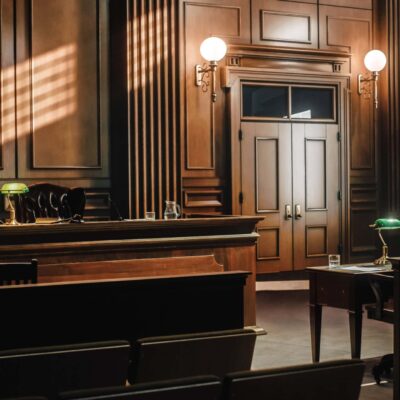At WIT, we stay ahead of emerging trends before the International Trade Commission (ITC) by tracking the procedural and strategic dynamics that shape Section 337 investigations. In assembling industry-specific expert teams for ITC litigants, WIT’s ITC Practice Team pays close attention not just to the technologies at issue, but also to the Administrative Law Judges (ALJs) who preside over these complex cases.
We recently spoke with our ITC Practice Chair, Jeffrey Dorfman, a seasoned New York attorney, to explore how ALJ-specific practices are influencing the course of investigations. With deep experience supporting clients before the Commission, Jeff and the WIT team are currently assisting on nearly half of all active ITC matters, advising on expert strategy and recommending top-tier technical, economic, and industry experts. We’ve summarized Jeff’s insights below in a streamlined, Q&A-style format to allow for easy reference and comparison across the ITC’s ALJs.
How does each ALJ approach expert testimony and disclosures at the ITC?
McNamara:
ALJ McNamara does not strictly apply Daubert and prefers to resolve expert disputes at the hearing, placing emphasis on live, in-person testimony. However, she enforces procedural rules rigidly—missing deadlines for contentions or reports can bar entire defenses.
Elliot:
ALJ Elliot limits testimony to the four corners of disclosed reports and uses real-time enforcement to strike unsupported statements. Supplemental reports require leave unless scheduled, and parties must identify prior disclosures on the record.
Cheney:
ALJ Cheney values in-person expert testimony and has emphasized that credibility is often shaped during live examination. He encourages attorneys to train associates on how expert evidence fits within the Federal Rules framework.
Bhattacharyya:
ALJ Bhattacharyya tends to limit or tailor expert testimony rather than exclude it outright. Her rulings show flexibility when experts have strong qualifications, even if procedural issues arise.
How have each of their ground rules evolved over time?
McNamara:
ALJ McNamara transitioned from requiring paper filings to fully digital submissions and now mandates precise redaction standards. She also added hearing-time incentives for junior counsel through her GR 16.
Elliot:
ALJ Elliot added GR 5.3, a formal three-stage case-narrowing process, and introduced real-time scope enforcement for expert testimony. He also limits each side to ten motions in limine to streamline pre-hearing practice.
Cheney:
ALJ Cheney hasn’t overhauled his ground rules but supports modernization and procedural clarity. He emphasizes the role of expert credibility in live hearings over pre-hearing challenges.
Bhattacharyya:
ALJ Bhattacharyya’s rulings show careful control over expert scope, though she hasn’t publicly revised her ground rules. She relies on case-specific enforcement rather than sweeping procedural changes.
What kinds of technologies appear most often in each judge’s docket?
McNamara:
Over 60% of ALJ McNamara’s investigations involve consumer electronics, with additional activity in OLEDs, pharmaceuticals, and wireless. She has also overseen several cases involving design patents.
Elliot:
Nearly half of ALJ Elliot’s docket is in networking and wireless, followed by automotive and life sciences. His cases cover a broad technical spectrum with a focus on communication technologies.
Cheney:
Chief ALJ Cheney has the broadest docket, with experience across 19 WIT categories including medical devices, automotive, and semiconductors. His assignments reflect the full scope of Section 337 subject matter.
Bhattacharyya:
ALJ Bhattacharyya’s ITC docket emphasizes digital streaming, power electronics, and life sciences. Her background also includes significant medical device and pharma experience from her time at OUII.
How does each ALJ approach scheduling for expert disclosures, Markman hearings, and evidentiary hearings in ITC investigations?
McNamara:
Her early cases had expert disclosures after Day 70, but more recent matters show a consistent shift to Days 50–66. This reflects a broader trend toward frontloading key case elements.
Elliot:
ALJ Elliot’s median expert disclosure date is Day 85.5, and he maintains phased scheduling to support case narrowing and clarity. His schedules emphasize structure and predictability.
Cheney:
ALJ Cheney tends to allow more time—his median expert disclosure is Day 98.5 and Markman hearings around Day 148. This pace reflects a deliberate and detailed case-building process.
Bhattacharyya:
ALJ Bhattacharyya’s schedules are well-structured and consistent, though her shorter tenure means less historical trend data. Her experience with OUII informs her disciplined timing and case pacing.
How has WIT used insights from our ALJ reports to guide expert selection for clients involved in 337 investigations before the ITC?
McNamara:
We guide clients to select credible experts who excel under live examination and meet every procedural deadline. Procedural discipline is critical to avoid exclusion under her approach.
Elliot:
For ALJ Elliot, we prioritize experts who stay within strict report scope and can defend disclosures in real time. His enforcement demands precision and cross-referenced documentation.
Cheney:
ALJ Cheney values clarity and credibility in expert testimony, especially at hearing. We help clients select experts who communicate effectively and understand how their opinions fit within the evidentiary framework.
Bhattacharyya:
We focus on domain-specific experts who stay within their lane and support every opinion with solid foundations. Her rulings reward both technical competence and strategic restraint.
Have any ALJs issued influential rulings on expert admissibility?
McNamara:
In Inv. 1356, she held that testing using “processed turkey lunchmeat” went to weight, not admissibility. She emphasizes that procedural violations—not reliability disputes—are grounds for exclusion.
Elliot:
ALJ Elliot enforces scope tightly—testimony must track precisely to written disclosures. In Inv. 1446, real-time enforcement was used to strike testimony lacking prior identification.
Cheney:
CALJ Cheney hasn’t issued high-profile exclusions but stresses live testimony and clear evidentiary integration. His public remarks highlight the role of expert credibility at hearing.
Bhattacharyya:
She has partially excluded experts who strayed from allowed topics but has also upheld testimony where credentials and relevance outweighed procedural concerns. Her rulings are case-specific and balanced.
What practical advice would you give attorneys preparing to appear before these ALJs?
McNamara:
Disclose early, follow every rule precisely, and prepare experts for live testimony. She rewards discipline and courtroom performance.
Elliot:
Don’t stretch expert scope—stay within disclosures and document everything. Real-time enforcement leaves no room for ambiguity.
Cheney:
Focus on narrative clarity and credibility. Your expert must be persuasive in the room, not just on paper.
Bhattacharyya:
Be precise and avoid overreaching. Strong credentials and focused testimony go a long way under her review.
How WIT’s Experts Can Assist in ITC Investigations
At WIT, we understand that ITC Investigations can be highly nuanced and have engaged with experts who possess a deep understanding of the major industries and technologies at issue before the Commission. Our ITC Practice features sector-specific teams of technical experts, knowledgeable industry veterans, and skilled specialists in code review and analysis who are dedicated to achieving the best outcomes for our clients, providing comprehensive support through every stage of the investigation process.
Contact us for more information about the ITC’s ALJs or our experts in 337 Investigations.




